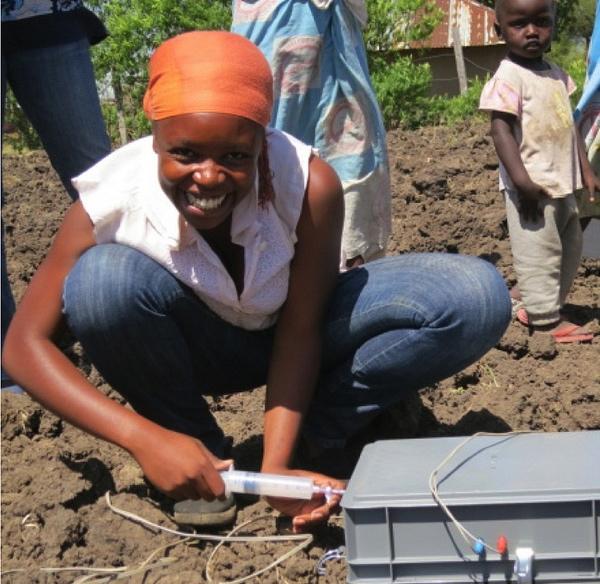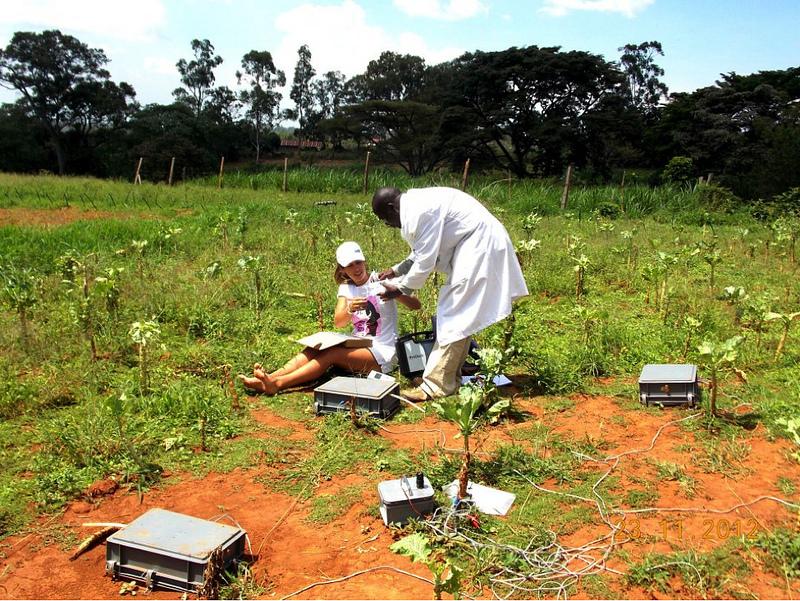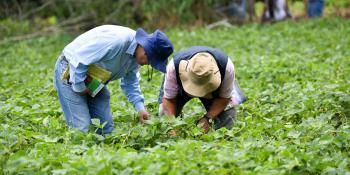Gas pooling: the best way to measure soil emissions more efficiently?

Greenhouse gas emissions from agricultural soils vary greatly over space and time, but CCAFS researchers in Kenya have found a way to more efficiently measure varying emissions from diverse landscapes- via gas pooling.
Agricultural soils are major sources of carbon dioxide and nitrous oxide, which are released when fertilizers are transformed by microbial processes in soil. To measure these gases, researchers usually use closed chambers placed on the soil surface, from which they collect gas samples with syringes.
However, emissions of these gases vary greatly across the landscape. To understand the largest sources of emissions, researchers must use many chambers. This means many, many gas samples to analyze.
What are the immediate challenges?
“The number of samples we needed to reliably estimate greenhouse gas fluxes quickly exceeded the capacity of our lab,” said Cristina Arias-Navarro during a discussion about the project.
Cristina Arias-Navarro is a researcher with CGIAR Research Program on Climate Change, Agriculture and Food Security (CCAFS) working on a project called Standard Assessment of Mitigation Potential and Livelihoods in Smallholder Systems (SAMPLES).
SAMPLES tries to develop low-cost guidelines to quantify greenhouse gas emissions and identifying mitigation options for smallholders at farm and landscape levels.
Read more: From field to landscape: Tackling mitigation and livelihoods with help from farmers

Bernadette Nangira, Graduate student at Maseno University in Kenya, collects gas samples from a closed chamber system. Photo: M. Rufino
Solution found!
To reduce the numerous gas samples required to quantify soil emissions of carbon dioxide and nitrous oxide, Arias-Navarro and her team conducted an experiment to determine if it was necessary to analyze each gas sample separately, or if they could combine the samples from several chambers before analyzing them—a method called “gas pooling”.
They developed a robust method to reduce the time and expense of measuring greenhouse gas emissions from agricultural landscapes, an important step toward making it possible for farmers and researchers to accurately assess climate-smart agricultural practices.
Download article: Gas pooling: A sampling technique to overcome spatial heterogeneity of soil carbon dioxide and nitrous oxide fluxes.

Cristina Arias-Navarro collects samples from the ground together with a colleague. Photo: M. Rufino
While combining samples may seem intuitive, the technique had never been proven.
“Pooling samples is a widely accepted methodology in soil analysis, but no one had ever tested it for gas sampling,” explained Arias-Navarro.
Flux determination using the gas pooling technique consists of obtaining composite gas samples from a number of chambers over time instead of sampling chambers individually.
We had the same results as using the conventional practice of analyzing samples from chambers individually, thus reducing the number of gas samples needed,” Arias-Navarro continued. “Pooling provides an opportunity to reduce the number of samples per site, possibly allowing for analysis of a greater number of treatments.”
While authors caution that the design of the gas pooling technique needs to be specifically adjusted based on the environment under investigation and the research questions of the experiment, this method could enable wider participation in climate-smart agricultural research by lowering the costs associated with measuring greenhouse gas emissions.
"This is a major advance for reducing the cost and increasing the practicality of greenhouse gas measurement," Lini Wollenberg, theme leader for CCAFS Low-Emissions Agriculture, said. "It will allow us to collect the robust data needed to accurately inform agricultural policies and practices."
Cristina Arias-Navarro is a Research Fellow at the Center for International Forestry Research, and a PhD student at Karlsruhe Institute of Technology (KIT) Institute of Meteorology and Climate Research. She is also a member of the Climate Food and Farming network, an initiative launched by CCAFS in collaboration with the Department of Agriculture and Ecology, University of Copenhagen.
Meryl Richards and Julianna White both work with Low-Emissions Agriculture.



